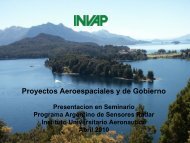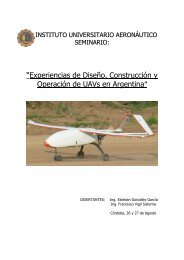Conceptual Design Requirements of a Newly Developed UAV as a ...
Conceptual Design Requirements of a Newly Developed UAV as a ...
Conceptual Design Requirements of a Newly Developed UAV as a ...
You also want an ePaper? Increase the reach of your titles
YUMPU automatically turns print PDFs into web optimized ePapers that Google loves.
− Weight <strong>of</strong> the aircraft<br />
− Flight altitude<br />
− <strong>Design</strong> clime rate<br />
− Flight speed<br />
In the present work it is proposed to use an engine with 17 to 22 hp, which corresponds<br />
to a weight to power ratio <strong>of</strong> 3.82 to 3. This will put proposed <strong>UAV</strong> among the top <strong>of</strong> the<br />
<strong>UAV</strong>'s list in terms <strong>of</strong> engine power and performance. Actually the main re<strong>as</strong>ons <strong>of</strong> that<br />
are the high cruise speed and the high operating temperature in the local environment,<br />
which is part <strong>of</strong> the objective for this project. To calculate the endurance <strong>of</strong> the <strong>UAV</strong> the<br />
weight ratio h<strong>as</strong> to be known. Table 2 is a list <strong>of</strong> most recent <strong>UAV</strong> engines specification<br />
available in the world market that can be used for the present project 8-11 . B<strong>as</strong>ed on present<br />
technology, the propulsion system is expected to weigh about 9 kg, including engine,<br />
propeller and generator.<br />
Table.2: Some <strong>UAV</strong> Engines available in the international market.<br />
Engine<br />
Output<br />
Weight Power /Weight ratio<br />
(Brand)<br />
(hp)<br />
(kg)<br />
(hp/kg)<br />
A200B<br />
17 5.1 / 6 kg (est.)<br />
2.83<br />
Quadra<br />
300W Gen.<br />
3W-200i B2TSQS<br />
20 4.8/6 kg (est.)<br />
3.67<br />
3W Motoren<br />
W.Gen<br />
313<br />
22 8<br />
2.75<br />
Zanzotterra<br />
W. 300w Gen.<br />
L275 E<br />
25 7.7 / 9 kg (est.)<br />
2.78<br />
Limbach<br />
W. Gen<br />
AR741<br />
37<br />
10.7 /12kg (est.)<br />
3.1<br />
<strong>UAV</strong> Engine Ltd. (rotary)<br />
W. Gen.<br />
B<strong>as</strong>ed on the calculated size <strong>of</strong> wing and fuselage, the airframe <strong>of</strong> the <strong>UAV</strong> is expected<br />
to have a weight between 10 and 16 kg, depending on design and material used for the<br />
construction <strong>of</strong> the system. Table 3 provides the design weight <strong>of</strong> different systems in the<br />
<strong>UAV</strong>.<br />
Fuel consumption can be estimated using figure 6, which is an example for typical<br />
turboprop engine 12 . From this figure we can use a conservative thrust specific fuel<br />
consumption <strong>of</strong> 0.06 kg/N.hr. Using equation 2 with the <strong>as</strong>sumption <strong>of</strong> having an<br />
aerodynamic performance <strong>of</strong> L/D=15, the <strong>UAV</strong> endurance will be 11.14 hrs. This satisfies<br />
the objective <strong>of</strong> the project.<br />
Airframe Propulsion Control &<br />
communication<br />
Table 3: Weights <strong>of</strong> different system in the <strong>UAV</strong>.<br />
Landing<br />
Gear<br />
Recovery<br />
System<br />
Payload<br />
(Max.)<br />
Fuel<br />
with<br />
max<br />
payload<br />
8<br />
SSAS <strong>UAV</strong> Scientific Meeting & Exhibition, Jeddah, Saudi Arabia (June 6, 2006)<br />
Paper No. SSAS-2006-051<br />
Gross<br />
Weight<br />
12 kg 9 kg 3 kg 4 kg 4 kg 10 kg 23 kg 65 kg








